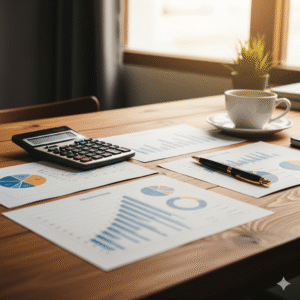The headlines are grim. Economic growth is slowing, companies are announcing layoffs, and financial news channels are filled with talk of a looming recession. For most people, the natural instinct is to protect their money at all costs—pulling it from the market, hoarding cash, and waiting for the storm to pass. But what if that instinct, born from fear, is the single biggest mistake you could make for your long-term financial future?
The idea of investing when the economy is shrinking seems counterintuitive, even reckless. Yet, history has shown, time and again, that periods of economic distress have created some of the most significant wealth-building opportunities for those with the knowledge and discipline to act. This isn’t about risky market timing or trying to catch a falling knife. It’s about understanding that recessions, while painful, are a normal part of the economic cycle—and they create a rare chance to buy into high-quality investments at a significant discount.
This guide will walk you through the why and how of investing during a recession. We’ll explore the historical data, debunk the fear-based myths, and provide you with actionable strategies to not only survive a downturn but to come out the other side in a stronger financial position.
What Exactly Is a Recession and Why Does It Scare Investors?

Before we dive into strategy, it’s crucial to understand what we’re dealing with. In simple terms, a recession is a significant, widespread, and prolonged downturn in economic activity. While there are complex academic definitions, the most common rule of thumb is two consecutive quarters of negative gross domestic product (GDP) growth. But it’s more than just a statistic; a recession is felt in the real world through:
- Rising Unemployment: Companies slow down hiring or lay off workers to cut costs.
- Reduced Consumer Spending: With less job security and income, people spend less on goods and services.
- Falling Corporate Profits: When people spend less, businesses earn less.
For investors, the fear is tangible. The stock market often declines sharply in anticipation of or during a recession, a period known as a bear market (a drop of 20% or more from recent highs). Watching the value of your 401(k) or brokerage account plummet is a deeply unsettling experience. This fear triggers a powerful psychological response, leading to a “herd mentality” where panicked investors sell their holdings to avoid further losses, often at the worst possible moment.
The key is to remember this: recessions are temporary. Since 1945, the United States has experienced 13 official recessions, and every single one has been followed by a period of economic recovery and expansion. While they feel all-encompassing at the moment, they are a cyclical and ultimately finite feature of the economic landscape.
The Historical Case: Why Downturns Are an Investor’s Best Friend
To understand the opportunity a recession presents, we don’t need a crystal ball—we need a history book. The data is clear: the periods following major market downturns have consistently delivered some of the best returns for investors who stayed the course or were brave enough to buy in.
Let’s look at the S&P 500, a broad measure of the U.S. stock market, during two of the most significant recessions of the modern era:
- The Dot-Com Bust (2000-2002): After the tech bubble burst, the market hit a low in October 2002. An investor who put $10,000 into an S&P 500 index fund at that point would have seen it grow to over $22,000 just five years later, a return of over 120%.
- The Great Financial Crisis (2008-2009): This was the most severe economic crisis since the Great Depression. The market bottomed out in March 2009. A $10,000 investment made at that terrifying moment would have grown to over $27,000 five years later—a staggering 170% return.
This pattern repeats throughout history. The market doesn’t wait for the “all clear” signal from the economy. It is a forward-looking mechanism, meaning the recovery in stock prices almost always begins while the economic news is still terrible. By the time unemployment starts to fall and GDP turns positive, the best buying opportunities have already passed.
This is the essence of legendary investor Warren Buffett’s famous advice: “Be fearful when others are greedy, and greedy when others are fearful.” A recession is the peak of financial fear, making it the prime time for disciplined, long-term investors to be “greedy” by purchasing assets at depressed prices.
Think Like a Shopper: The Stock Market Is on Sale

Imagine your favorite store announced a 30% off sale on everything. You’d likely rush to buy the items you’ve been wanting. Yet, when the stock market does the exact same thing, the common reaction is to run away.
A recession puts the entire stock market on sale.
A bear market driven by recession fears tends to be indiscriminate; it pulls down the prices of excellent, world-class companies right along with the weaker ones. This allows you to buy shares in fundamentally strong businesses—companies with durable competitive advantages, healthy balance sheets, and consistent profitability—at prices you might not see for another decade.
Your goal isn’t to buy just any stock because it’s cheap. It’s to acquire a piece of a great business at a fair, or even a discounted, price. The fear and panic of a recession provide that discount. You are not just buying a ticker symbol on a screen; you are buying a share of future earnings and growth. When the economy inevitably recovers, these strong companies are often the first to rebound, and their stock prices tend to recover much faster than the broader economy.
Smart Strategies for Investing During a Recession
Simply knowing that a recession is a good time to invest isn’t enough. You need a practical, disciplined strategy to navigate the volatility and avoid emotional mistakes.
1. Embrace Dollar-Cost Averaging (DCA)
If there is one “magic formula” for investing in a downturn, this is it. Dollar-cost averaging is the practice of investing a fixed amount of money at regular intervals (e.g., $200 every month), regardless of what the market is doing.
- How it works: When prices are low during a recession, your fixed investment amount automatically buys more shares. When prices recover, you buy fewer shares. Over time, this lowers your average cost per share compared to investing a lump sum.
- It removes emotion: DCA is an automated strategy. It prevents you from trying to time the market and protects you from the two most destructive emotions: fear and greed. You keep investing methodically, turning market volatility into an advantage.
2. Focus on Quality and Defensive Sectors
Not all stocks are created equal, especially during a recession. This is the time to prioritize quality and resilience.
- Defensive Stocks: These are companies in sectors whose products and services people need regardless of the economic climate. Think of consumer staples (Procter & Gamble, Coca-Cola), healthcare (Johnson & Johnson, Pfizer), and utilities (your local energy provider). These companies tend to have more stable earnings and often pay reliable dividends, which can provide a cushion during market declines.
- Strong Balance Sheets: Look for companies with low debt levels and plenty of cash on hand. These are the businesses that can withstand a prolonged economic slump, continue to invest in growth, and even acquire weaker competitors.
3. Reaffirm Your Commitment to Diversification
Diversification is always important, but its value is never more apparent than during a recession. Spreading your investments across various asset classes can help cushion the blow when one part of your portfolio is hit hard. A properly diversified portfolio includes:
- Stocks: Across different industries (tech, healthcare, financials) and geographies (U.S., international).
- Bonds: High-quality government and corporate bonds often act as a stabilizer. When stocks fall, investors often flock to the safety of bonds, pushing their prices up.
- Real Assets: Assets like real estate (through REITs) or commodities can offer further diversification and protection against inflation.
4. Don’t Be Afraid to Rebalance
Rebalancing is the act of periodically selling some of your winning assets to buy more of your losing ones, bringing your portfolio back to its original target allocation (e.g., 60% stocks, 40% bonds). A recession makes this strategy incredibly powerful. As your stocks fall in value, your portfolio might drift to 50% stocks and 50% bonds. Rebalancing would mean selling some of your relatively stable bonds and using the proceeds to buy more stocks at their depressed prices—a disciplined way to “buy low.”
Your Own Worst Enemy: The Psychology of a Downturn

The biggest challenge of investing in a recession isn’t analytical; it’s emotional. Understanding the psychological traps you’re likely to face can help you avoid them.
- Loss Aversion: Decades of behavioral economics research have shown that the pain of a loss is about twice as powerful as the pleasure of an equivalent gain. This is why seeing your portfolio drop 20% feels so much worse than the joy of it rising 20%. This feeling drives the impulse to sell and “make the pain stop.”
- Confirmation Bias: When you’re scared, you’ll naturally seek out information that confirms your fears—scary headlines, pessimistic expert opinions. This creates an echo chamber of negativity that makes it seem like selling is the only rational choice.
- Capitulation: This is the ultimate danger point. After months of market declines, many investors simply give up. They conclude that the market will never recover and sell everything near the absolute bottom, locking in their losses permanently and missing the subsequent recovery.
To combat these biases, you need a plan. Write down your investment goals and your strategy before a downturn hits. When you feel the panic setting in, refer back to your plan and remind yourself why you are a long-term investor.
Before You Invest: A Crucial Financial Health Checklist
The opportunity to invest during a recession is powerful, but it’s only for money you can afford to put at risk for the long term. Before you deploy a single dollar into a falling market, you must ensure your personal financial house is in order.
- Build a Robust Emergency Fund: This is non-negotiable. You need at least 3 to 6 months’ worth of essential living expenses saved in a high-yield savings account. This is your safety net if you lose your job, ensuring you won’t be forced to sell your investments at a loss to cover rent or groceries.
- Eliminate High-Interest Debt: Paying off credit card debt with an 18% interest rate is a guaranteed 18% return on your money. It makes no sense to invest for a potential 10% return while simultaneously losing 18% to debt.
- Assess Your Income Stability: Be realistic about your job security. If you are in a highly cyclical industry, you may want to bolster your emergency fund even further before investing more aggressively.
- Confirm Your Time Horizon: Never invest money in the stock market that you will need in the next five years. The market is too unpredictable in the short term. Money for a down payment on a house in two years belongs in a safe place like a savings account or CD, not the S&P 500.
Seize the Opportunity Fear Creates

Investing during a recession is not for the faint of heart. It requires conviction, discipline, and the ability to look past today’s terrifying headlines toward a more prosperous future. But for those who are prepared, it represents an unparalleled opportunity.
Recessions are not a time to abandon your financial plan; they are the moments when a good plan proves its worth. By continuing to invest consistently, focusing on quality, and controlling your emotions, you are not just weathering the storm—you are actively harnessing its power to build long-term wealth. Years from now, when the economy is booming again, you will look back on this period not with fear, but with the satisfaction of knowing you made the bold, smart decision to invest when almost no one else would.







